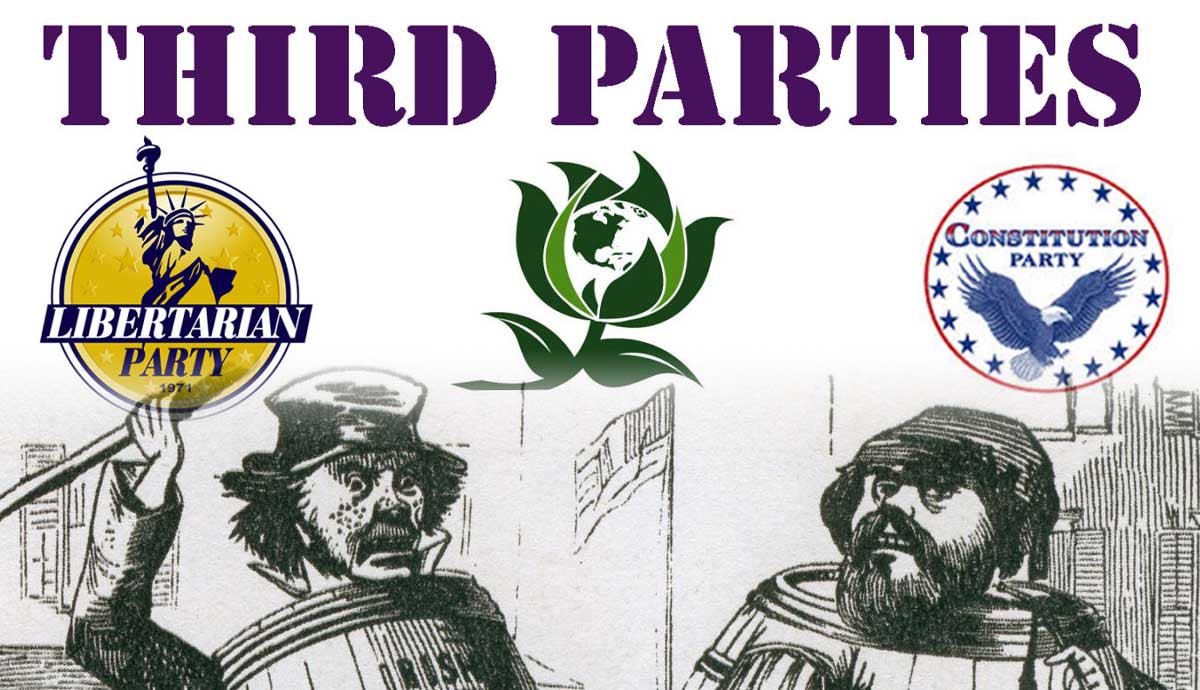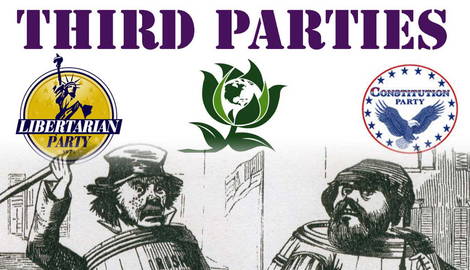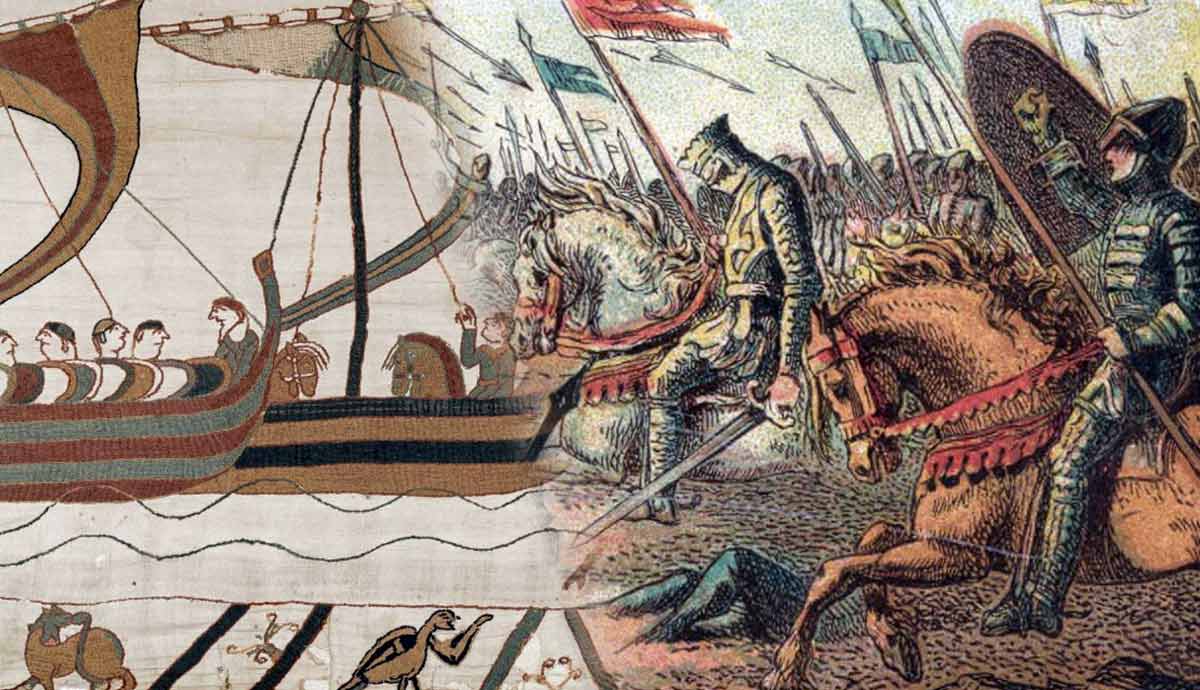
Everyone knows the two major players in American politics: the Democratic Party and the Republican Party. At all elections above the municipal level in the United States, these two political parties are dominant, with very few county- or state-level politicians coming from third parties. What are third parties, and do they have any influence in American politics? Are there any widely known third parties? Why have we never had a US president from a third party? If not, why do people ever vote for third-party candidates? Here’s a look at the hidden role and power of third parties in United States elections.
Setting the Stage: Birth of Partisanship in the USA

When the United States Constitution was written in Philadelphia in 1787, the famous governing document did not include political parties. In fact, factions were a key concern of some of the Founding Fathers, including Constitution writer James Madison. However, despite George Washington’s warning to Americans to avoid political parties, Madison assumed that factions were inevitable. To limit the power of factions to become tyrannical and oppress others, Madison wanted the US Constitution to create systems and processes that would prevent any one faction from becoming dominant.
In The Federalist Papers, Madison skillfully argued—and persuaded the voting public—that having many competing factions in a large republic would limit the growth of any one. He further argued that the ambitions of faction leaders, politicians and candidates, would naturally check the rise of a dominant faction. To compete and win, factions would need to moderate themselves to appeal to large numbers of voters. Madison’s beliefs were quickly put to the test in 1796 when Federalist Vice President John Adams ran for the presidency against Democratic-Republican Secretary of State Thomas Jefferson. Adams won in 1796, but lost in 1800. Fortunately, Adams willingly handed over the presidency to Jefferson in the Peaceful Revolution of 1800, showing that partisanship could be intense without devolving into violence.
Early 1800s: Emergence of the Two-Party System

The Federalists and the Democratic-Republicans were the first two organized factions, or political parties, that could compete across the growing nation. Why did more political parties not develop? In the Constitution, the United States was set up to have single-member legislative districts, meaning only one person can represent a given district in a legislature (lawmaking body). In state legislatures and the US House of Representatives, each district can send only one elected official. This creates a “winner take all” principle in American politics; the candidate who receives the second-most votes gets nothing.
In addition to the winner-take-all principle, American elections tend to be plurality elections above the local level. All federal elections, meaning for Congress and the president, are plurality elections. This means that the winner of the election is whichever candidate wins the most votes—not necessarily a majority of votes. Because of this, there is little need to create coalitions of small political parties. The biggest party wins outright, dooming parties that cannot win plurality elections quickly to irrelevance. Historically, this has left two main political parties in countries like the United States, Britain, Canada, Jamaica, and Zimbabwe.
1850s: The Know-Nothing Party

By the 1840s, two dominant political parties had emerged in the United States: the Democratic Party and the Whig Party. The Democrats were more powerful in the South and represented mainly agrarian interests. Meanwhile, the Whigs were more powerful in the North and were more urban. However, the Whig Party began to lose power quickly in the 1850s as it broke into smaller factions over the divisive issue of slavery. While the Whig Party still existed, an offshoot became known as the Know-Nothing Party.
The Know-Nothings were nativists who argued that immigrants were destroying American society. This was a popular sentiment in the cities of the Northeast, which experienced rapid immigration from Europe starting in the 1840s. At its peak in 1856, the Know-Nothing Party had a national profile and even enjoyed a former Whig, incumbent US president Millard Fillmore, jumping on board as its presidential nominee. Fillmore received only eight electoral votes—trounced by both the Democratic Party and newly-established Republican Party nominees—and the Know-Nothing Party collapsed, mostly due to disagreements over slavery.
1860: The Constitutional Union Party

The new Republican Party was mainly composed of former Whigs, but some Whigs preferred to experiment with third parties. After the Know-Nothing Party collapsed after 1856, a second post-Whig third party emerged: the Constitutional Union Party. This party was focused on maintaining the union, which was rapidly fracturing over the issue of slavery. It appealed mostly to conservatives from both major parties, especially as some Democrats came to fear growing radicalism in their party. In 1860, the Constitutional Union Party was formed and tried to promote unity…by ignoring the issue of slavery.
Texas governor Sam Houston and Tennessee politician John Bell competed for the party’s first presidential nomination, with Bell winning out. Unfortunately for the fledgling party, most voters stuck with traditional partisanship that fall. The Democratic Party itself split between North and South, with each coalition running its own nominee. Thus, four major candidates competed in November, with Republican nominee Abraham Lincoln winning a plurality of the popular vote and enough votes in the Electoral College. Bell received the least votes, and the Constitutional Union Party collapsed with the outbreak of the Civil War.
1892: The People’s “Populist” Party

The Union victory in the Civil War was a tremendous boost to the Republican Party of Abraham Lincoln. Democrats were long seen as Southern supporters of slavery, and thus, the Democratic Party entered a post-war era of irrelevance. However, the Republican Party quickly became known more for being the political party of “big business,” and many poor workers felt that their interests were ignored. If Democrats were the party of agriculture and Republicans were the party of the wealthy, who would be the party of labor?
Quickly, the People’s Party, also known as the Populist Party, emerged in the late 1880s. It sought economic reform to limit the power of banks and railroads. Many farmers joined urban labor as populists, feeling that the Democratic Party was beholden to wealthy landowners. In the 1892 presidential election, the Populist Party won over a million popular votes with nominee James B. Weaver. The federal election also saw some Populists win seats in Congress, which was a rarity for a third party. Would the Populist Party break the two-party system?
1896: Major Party Absorbs a Third Party

While the Know-Nothings and Constitutional Unionists largely collapsed, the Populists seemed to be maintaining their popularity. However, they were thwarted in many places by the winner-take-all principle as they were not able to overcome Democrats or Republicans directly. Quickly, both the Democratic and Republican parties began adopting parts of the Populist platform to retain their own voters and attract some Populist voters. This prevented the Populist Party from growing enough to become a third major party.
In 1896, populist leader William Jennings Bryan became the Democratic Party’s presidential nominee. Many Populists joined Bryan and merged with the larger Democratic Party, adding urban labor issues and economic reforms like increasing the money supply to the Democratic Party platform. Some Populists in the South also merged with the Republican Party, mostly due to disagreement with some anti-Black Democrats. Ultimately, the Populists faded away as most members joined one of the two major parties, with Democrats and Republicans both putting forth some Progressive policies in the late 1890s and early 1900s.
1912: The Progressive “Bull Moose” Party

While Millard Fillmore is often considered a largely forgettable US president, the next commander-in-chief to jump ship from a major party to a third party was a historical leader. Theodore Roosevelt, often considered the nation’s top Progressive reformer, was a Republican president from 1901 to 1908. He voluntarily passed up a third term and let a Cabinet secretary, William Howard Taft, take the reins. By 1912, however, Roosevelt was dissatisfied with Taft and pursued the Republican presidential nomination again.
When the Republican Party decided to stick with Taft, an angry Roosevelt formed his own party: the Progressive, or “Bull Moose,” Party. Roosevelt campaigned hard and beat Taft out in the popular vote. Despite this rare example of a third party beating a major party, the other major party won an even greater percentage. Roosevelt’s run effectively split the Republican vote, letting the Democratic Party win a plurality. Woodrow Wilson became the first Democratic president in decades. The stinging loss created a lesson for both major parties: take care to maintain party unity, lest you split your votes!
1912-20: Eugene V. Debs and the Socialists

One politician who cut his teeth during the populist era of labor strikes was Eugene Debs. In 1912, with the Republican Party split by Teddy Roosevelt’s new Progressive Party, Debs also made headway as presidential nominee for the Socialist Party. In his fourth race as Socialist nominee, Debs won almost one million popular votes. The Socialist Party, a minor third party, continued on, and Debs ran for president for a fourth time in 1916.
In 1918, the United States had entered World War I, and Debs—a pacifist—made a speech criticizing America’s role in the conflict. He was arrested under the new Espionage Act, which allowed the government to limit speech that might be harmful to the war effort. Two years later, Debs campaigned for the US presidency from a prison cell, making him the first to do so. Perhaps due to Socialist fervor thanks to the recent Bolshevik Revolution in Russia, or perhaps due to public sympathy for his plight, Debs won over one million popular votes. He was released from prison by election’s victor, Republican nominee Warren G. Harding.
1948-68: The “Dixiecrats” and American Independent Party

The Civil Rights movement ruffled both major parties, especially the Democratic Party. Since the end of post-Civil War Reconstruction, the South had been dominated by the Democratic Party. Beginning with Franklin D. Roosevelt, however, the party had shifted its base of support from Southern farmers to urban labor. In 1948, Roosevelt’s vice president, Harry S. Truman, was now in the White House, and he made the monumental decision to desegregate the armed forces. Angrily, many Southern Democrats split off to create their own party, the pro-segregation and pro-states’ rights Dixiecrat Party.
The Dixiecrats at first tried to work within the larger Democratic Party but failed to prevent Truman from being re-nominated. In the general election, the Dixiecrats won 39 electoral votes but again failed to stop Truman, who won re-election. This failed effort resulted in most Dixiecrats sullenly returning to the Democratic Party. Twenty years later, Alabama Governor George Wallace (who did not join the Dixiecrat movement in 1948 despite strong sympathies) created a similar movement known as the American Independent Party. In a strong showing for a third party, Wallace won 46 electoral votes.
Today: Greens and Libertarians

Today, the two largest third parties in the United States are the pro-conservative Libertarian Party and the pro-liberal Green Party. Libertarians are often called “small government conservatives” and favor low taxation, little government involvement in regulating personal behavior, and free market principles. In this regard, they are sometimes described as conservative on economic issues and liberal on social issues. For the past two presidential elections, the party’s nominee has had ballot access in all 50 states.

The Green Party is primarily liberal and focuses mostly on environmental issues, social justice, and world peace. In 2020, the party was on the ballot in 30 states, and presidential nominee Howie Hawkins was an accepted write-in candidate in 17 more. Compared to the Libertarian Party, the Green Party’s reduced ballot access may stem from Democratic voter anger in 2000 and 2016, when the Green Party presidential nominee was considered a spoiler by taking away Democratic votes in key swing states and helping the Republican nominee win the election. As a result, fewer state residents may be willing to sign petitions to grant the Green Party ballot access.










